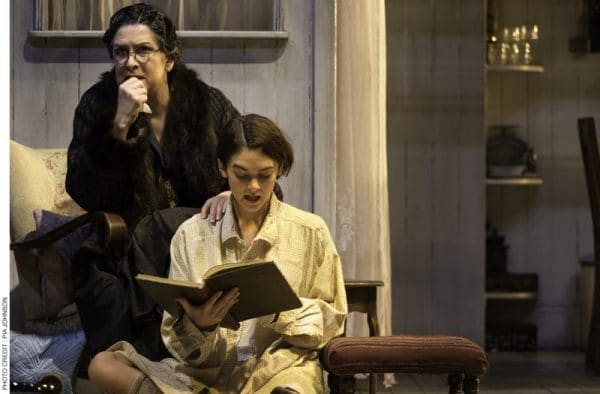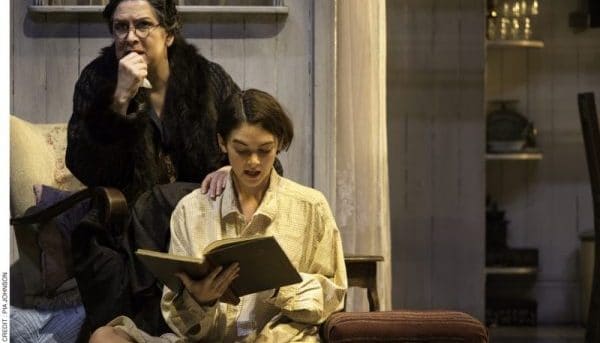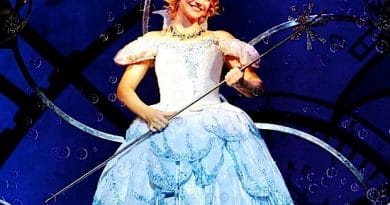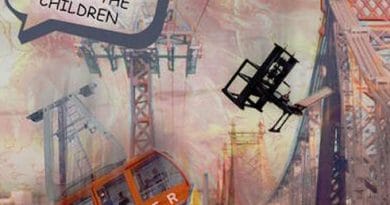Malthouse: The Glass Menagerie
The narrator tell us The Glass Menagerie is a memory play. The narrator is also a character in the play. He is also a thinly-veiled version of playwright Tennessee Williams. Currently at Malthouse Theatre, actor Luke Mullins draws the audience into the play and then into the home of Tom, his mother Amanda (Pamela Rabe) and his sister Laura (Rose Riley).

Tom and the narrator and Tennessee remind us that memory is fallible; it’s constructed and re-constructed each time we revisit our own history. And so to this play, which parallels much of Tennessee’s life – but is also, very clearly, not his life. It is a figment of it. An impression. A recollection.
The original text of the play is preceded by lengthy production notes, and the scenes are described in detail. Because it is a memory play, Williams doesn’t want any production to adhere to realism. It does not need “a Frigidaire and authentic ice-cube trays”. The characters should not speak as the audience speaks. He specifies the type of music he wants and suggests a lighting design. And, most memorably, he talks in detail of “the screen device” – upon which are projected “magic-lantern slides bearing images or titles”.
The use of screens and video in theatre has become a regular trick in big budget musicals and on our theatre main stages. Benedict Andrews’s use of video in Sydney Theatre Company’s The Maids was astonishing. A similar design in Melbourne Theatre Company’s recent production of Miss Julie paled in comparison.
Director Eamon Flack takes Williams’s descriptions of screens and title cards – which is all the playwright could have expected in a 1940s production – and lays in the use of video, which is constantly manipulated by the narrator. Luke Mullins constructs the narrator, who constructs Tom and they construct a play written seven decades ago. Mullins moves video cameras around the stage to catch moments obscured by the walls of the apartment where the Wingfields live.
The set (Michael Hankin) is evocative of the thirties in America, and the lighting (Damien Cooper) is a constant shift through night, day and twilight – a magic hour in which a gentleman caller arrives and upends everyone’s expectations.
But much like the movies that Tom says he escapes to, for adventure, these video images aren’t clear and often deceptive. Williams wanted the opening scenes to play behind gauze; here we see the family behind lace curtains. The cameras help to peek inside, but they do not always give us the full picture. Memory obfuscates the truth. The narrator gives us “truth in the pleasant disguise of illusion”.
Pamela Rabe is extraordinary as Amanda Wingfield. It would be very easy to give into the histrionics of the character as written, but Rabe brings a real warmth to Amanda, allowing for some good humour between herself and Mullins’s Tom. Her interactions with Joe, the gentlemen caller (Harry Greenwood) are in some moments hilarious – giving much-needed levity to the second act.
And it’s hard to take your eyes off Mullins’s Tom, even as he observes or manipulates the set and the cameras. His sense of control is masterful, even when his performance tends toward camp; we never lose the sense of the pained man who can do nothing but watch. And re-create.
I saw the original season of this production at Belvoir in Sydney in 2014. This remount at the Malthouse feels like an imperfect reconstruction of that memory. Belvoir’s angled, thrust stage is not re-created here. This version plays on a much more traditional proscenium; the arch into the family living room compounds this feeling. Where I felt immersed at Belvoir, I felt at a slight distance in the Merlyn.
I had the memory of that first encounter with this production as I sat watching. And now I have two experiences of this production: almost alike, but not quite. As perfect a reconstruction as I could expect in such different spaces. In any case, I am very glad I saw The Glass Menagerie for a second time. You should see it and see it again, too. I guarantee it will last in your memory.




